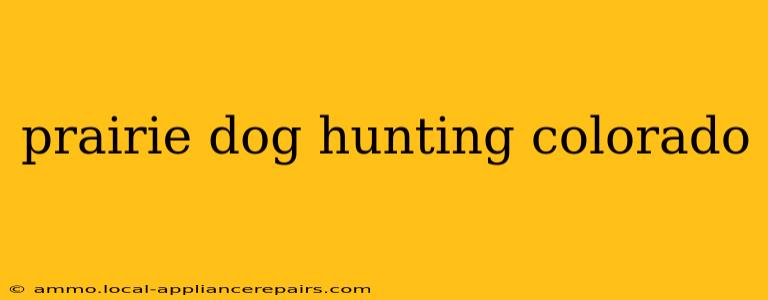Colorado's vast prairies are home to thriving prairie dog populations, making the state a popular destination for prairie dog hunters. This comprehensive guide covers everything you need to know for a successful and responsible hunting trip, from understanding regulations to mastering hunting techniques.
Understanding Colorado's Prairie Dog Hunting Regulations
Before you even think about grabbing your rifle, familiarize yourself with Colorado Parks and Wildlife (CPW) regulations. These regulations are crucial for ensuring a safe and legal hunt. Key aspects to consider include:
- Licensing: You'll need a valid Colorado hunting license. Specific license types may be required depending on your age and residency status. Check the CPW website for the most up-to-date information.
- Season Dates: Prairie dog hunting seasons vary by region and often extend throughout much of the year. Always verify the specific dates for your chosen hunting area on the CPW website.
- Bag Limits: There are usually daily and seasonal bag limits for prairie dogs. Exceeding these limits carries significant penalties.
- Land Access: Ensure you have permission to hunt on private land. Public land hunting is also possible, but you'll need to familiarize yourself with the specific regulations and access points for your chosen area. Many national forests and BLM lands allow prairie dog hunting.
- Weapon Restrictions: While many firearms are permissible, restrictions might apply. Check CPW regulations for specifics on allowed calibers and firearm types.
Choosing Your Hunting Location and Tactics
Colorado offers diverse landscapes ideal for prairie dog hunting. Consider these factors when selecting your hunting location:
- Prairie Dog Density: Areas with high prairie dog populations naturally provide better hunting opportunities. Conduct thorough research or consult with local experts to identify prime locations.
- Terrain and Accessibility: Assess the terrain's challenges and ensure you have the appropriate vehicle and gear for accessing your chosen location.
- Wind Conditions: Wind can significantly impact your shooting accuracy. Favor calm or low-wind days for optimal results.
Effective prairie dog hunting requires a strategic approach:
- Long-Range Shooting: Prairie dogs are often found at considerable distances, so proficiency with long-range shooting techniques and equipment is essential. Practice your shooting skills beforehand.
- Calling: While not strictly necessary, using a prairie dog call can sometimes attract more animals to your position, increasing your hunting opportunities.
- Patience and Observation: Prairie dogs are alert creatures. Patience, careful observation, and a stealthy approach are paramount to a successful hunt.
- Camouflage: Blending in with the environment through appropriate clothing will increase your chances of success.
Essential Gear for a Successful Hunt
Proper gear is crucial for a safe and effective prairie dog hunt. Consider packing:
- Suitable Rifle: A .223 Remington, .22-250 Remington, or similar caliber rifle is generally well-suited for prairie dog hunting.
- Optics: A quality scope is indispensable for accurate long-range shooting. Binoculars are also helpful for spotting prairie dogs from a distance.
- Ammunition: Bring plenty of ammunition.
- Shooting Rest: A shooting rest or bipod will significantly improve your accuracy and stability.
- Protective Gear: Eye and ear protection are essential for safety. Consider wearing gloves and appropriate clothing for the weather conditions.
- First-Aid Kit: Always carry a well-stocked first-aid kit.
- Navigation Tools: GPS or a map and compass are helpful, especially in unfamiliar terrain.
Ethical and Responsible Hunting Practices
Responsible hunting is paramount. Always adhere to these ethical principles:
- Respect Property Rights: Obtain permission before hunting on private land.
- Follow Regulations: Strictly adhere to all CPW regulations regarding bag limits, seasons, and weapon restrictions.
- Safety First: Prioritize safety by handling firearms responsibly and always being aware of your surroundings.
- Clean Up After Yourself: Leave the hunting area clean and free of litter.
- Harvesting: Ensure humane dispatch of the animals.
This guide provides a solid foundation for planning your prairie dog hunting trip in Colorado. Remember to always consult the official Colorado Parks and Wildlife website for the most current regulations and safety information before you go. Happy hunting!

